The students of today’s Web 2.0 world do not know a life without technology. Before they hit the age of 20, they will have sent and received over 200,000 email and instant messages, but will have spent less than 5,000 hours reading books (Prensky, 2001). They are a generation of Digital Natives (Prensky, 2001), having been born into a world of computers, cell phones, and immediate access to people and information from all over the world with the push of a button. In order to better meet the ever-changing needs of their learners, teachers need to access their students’ digital funds of knowledge (Moll, Amanti, Neff, & Gonzalez, 1992) to harness this wealth of technological skill in the pursuit of literacy growth.
In this review, three different perspectives on the literacy needs of 21st-century students were integrated. The National Council of Teachers of English (NCTE, 2008) Position Statement was utilized because it identified the new literacy skills students need. Likewise, Lankshear and Knobel’s (2006) work was incorporated because it offered theoretical support for the literacies defined in the NCTE statement. Finally, Cummins, Brown, and Sayers (2007) was included because it emphasized the possibilities of technology in achieving literacy goals. In blending these three perspectives, we created a framework by which to assess the incorporation of technologies in classrooms as a means to build students’ new literacies. Finally, as a specific example, our framework was applied to the use of wikis to illustrate the literacy learning potential of both wikis and other new technologies.
Existing Perspectives
The first perspective on which the evaluation framework was based was that of the NCTE, which acknowledged that as times and technologies change, so have the literacies and literacy needs of students. In its Position Statement, NCTE (2008) acknowledged the increasing literacy demands that have emerged due to ever-changing technologies. They further claimed that these new literacies are, “multiple, dynamic, and malleable,” citing the following skills as being necessary for 21st-century readers and writers:
- Develop proficiency with the tools of technology
- Build relationships with others to pose and solve problems collaboratively and cross-culturally
- Design and share information for global communities to meet a variety of purposes
- Manage, analyze and synthesize multiple streams of simultaneous information
- Create, critique, analyze, and evaluate multi-media texts
- Attend to the ethical responsibilities required by these complex environments. (National Council of Teachers of English, 2008)
A second viewpoint included in this evaluative framework came from the work of Lankshear and Knobel (2006), who took a more theoretical approach in emphasizing the essential nature of grounding pedagogical decision-making, especially as it related to electronic learning, in a sociocultural perspective. They lamented the wasted “potential of new technologies to provide bridges to new forms of social and cultural practice that school education could and should be interested in, like critical engagement with new literacies” (p. 195). In response, they stated several principles on which to evaluate curricular and pedagogical uses of technology from a sociocultural perspective. Among these were
- The principle of efficacious learning: For learning to be efficacious it is necessary that what somebody learns now is connected in meaningful and motivating ways to mature or insider versions of Discourses…
- The principle of integrated learning: From a sociocultural perspective, learning is integrated to the extent that…[it] occurs inside a practice rather than at a distance; …the various “bits” of social practices that go together…are learned in their relationships to one another, as a consequence of learning them inside the practice(s); …[and] our learning is the more integrated the less it clashes with who and what we are and do in the other discursive dimensions of our lives…
- The principle of productive appropriation and extension in learning involves looking for ways to reduce or ameliorate conflict between social identities during learning; [and] if learners already know how to perform discursive roles and tasks that can legitimately be carried over into new discursive spaces, this can be used to advantage to enable learning and proficiency in a new area…
- The principle of critical learning: It is necessary to create spaces for developing and negotiating differing points of view on social practices, social identities, social institutions, and the like. (Lankshear & Knobel, 2006, pp. 195-199)
The final perspective included in the framework stemmed from the focus of Cummins et al., (2007) on the incorporation of optimal learning environments with technology-supported instruction, focusing on the inclusion of specific software programs and learning activities. They identified the following criteria that teachers should meet when utilizing technology to support their students’ literacy development:
- Does the technology-supported instruction provide cognitive challenge and opportunities for deep processing of meaning?
- Does the technology-supported instruction relate instruction to prior knowledge and experiences derived from students’ homes and communities?
- Does the technology-supported instruction promote active self-regulated collaborative inquiry?
- Does the technology-supported instruction promote extensive engaged reading and writing across the curriculum?
- Does the technology-supported instruction help students develop strategies for effective reading, writing, and learning?
- Does the technology-supported instruction promote affective involvement and identity investment on the part of students? (Cummins et al., 2007, pp. 109-110)
The principles forwarded by these perspectives address the needs of both teachers and students in the 21st-century classroom, but in slightly different ways. In reviewing the criteria presented from these three perspectives, overlaps and fundamental concepts were identified. We decided that in collapsing these viewpoints, one teacher-friendly framework could be established that takes into account students’ sociocultural as well as pedagogical needs. The framework has six core questions to be addressed when evaluating classroom implementation of technology in literacy instruction, asking in what ways the use of the technology under consideration:
- Advances students’ social, emotional, and identity development by giving students agency, ownership, and/or personal voice?
- Provides opportunities for collaborating and sharing information in local and/or global settings?
- Promotes critical literacy opportunities such as evaluating content and considering different points of view?
- Allows for the processing, managing, analyzing, and synthesizing of multiple streams of information?
- Aids in developing literacy strategies for managing different types of text in a variety of contexts?
- Values and utilizes students’ cultures, experiences, and funds of knowledge?
A critical analysis of technology use framed by these questions can guide teachers in their decisions regarding how and why to use particular technologies to facilitate learning for their 21st-century students. Applying this framework to a wiki, for example, illustrates how it can be utilized to evaluate one such digital tool.
Wikis
A wiki is just one example of a socially based or Web 2.0 technology that can be implemented to meet new literacy needs of today’s students (NCTE, 2008). A wiki is a communally generated website on which anyone is free to add, change, or delete content, sharing the responsibility for its growth amongst all of its contributors (Mindel, 2006). Wikis are free to access and relatively easy to use, requiring skills no more complicated than those of word processing programs (Raman, Ryan, & Olfman, 2005). There are many sites that offer free wiki pages and simple step-by-step instructions for teachers to use. Among these are TeachersFirst, WikiWorks, Wikia, PB Works, and Wiki Spaces. See Figure 1 for an example of how to create a wiki on PB Works. (Editor’s Note: Website URLs can be found in the Resources section at the end of this paper.)
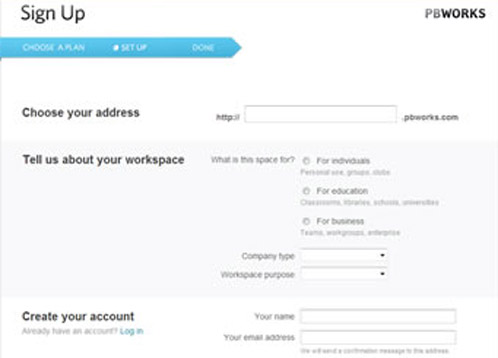
Figure 1. Screen shot of sign-up page on PB Works.
Once a teacher sets up the site and communicates expectations for its use, students can begin to add evidence of their own growing understanding in interactive and collaborative ways. A few potential strengths of the wiki as an educational tool include its interactive nature as well as its unique format. Students can contribute not only text, but also original or downloaded images, hyperlinks, videos, or any other forms of communication that can be digitally accessed or created. Some other features inherent in wikis that set it apart from basic word processing include the ways in which documents, images, and presentations can be stored, retrieved, and searched for; the ways changes to the pages are managed; and the opportunities provided for online discussions. For example, the wiki format allows users to track changes by name and date and can be set up so that contributors receive notification when changes are made.
Wikis make available a format for asynchronous discussion to take place at the convenience of the users (Raman et al., 2005); students can respond to each other at any place and any time via the wiki, and the conversations are tracked by name, subject, date, and time. Organized by content rather than by chronology (Engstrom & Jewett, 2005), wikis have the potential to enhance learning through the generation of shared understandings across time, distance, and interruptions (Mindel & Verma, 2006). This collection of group knowledge that is both active and dynamic has the capability of creating new knowledge greater than the sum of its collective parts (Raman et al., 2005).
Applying the Integrated Framework
By applying the evaluation framework to the use of wikis in literacy education, vast possibilities for rich learning experiences can be seen. However, wikis alone cannot do anything; their potential to provide opportunities for literacy growth is dependent on their effective implementation by teachers. In considering the educational use of wikis to address literacy needs, the following questions may be asked.
1. In what ways can teachers’ use of wikis advance students’ social, emotional, and identity development by giving students agency, ownership, and personal voice? Contributions to a wiki site inherently provide students with opportunities to make themselves heard as they view others’ contributions and add their own knowledge. Mindel and Verma (2006) stated that wikis, used in an instructional situation, can blur the distinction between reader and contributor, promoting a view of the teacher as a facilitator of knowledge-sharing among students rather than as a distributor of knowledge to students. All contributors are placed on an even playing field and the hierarchical mindset that typifies most other text formats is removed. The decreases in division between producers and consumers of knowledge allow students to assume ownership of and agency for knowledge creation.
However, merely developing a class wiki does not provide students with opportunities for agency, ownership, and personal voice if teachers set rigid guidelines for students to follow. Setting specific topics and not letting students stray, making them use a particular writing style, tone, or vocabulary, and doing all of the editing themselves are a few ways in which teachers’ incorporation of wikis could hamper rather than enhance students’ literacy success. Therefore, in order to allow the technology to promote student ownership, agency, and voice, teachers must make sure that the wiki is truly a space in which all members of the class are encouraged to express themselves and contribute their unique perspectives.
The possibilities that exist for students to collaborate in the creation of their own knowledge base for literacy learning is exemplified in shsaplit wiki created by AP Literature & Composition classes at Suffern High School in Suffern, New York. For example, students created literature review materials for the texts read during the year, utilizing a variety of print and online resources to contribute to such topics as character exploration, central themes, and historical contexts of the literature under study. Students were provided the opportunity to develop and express understandings of complex literacy topics through their own explorations and through reading the work of their peers in their joint contributions to the class wiki site.
On the Suffern High School wiki, the topics explored vary from text to text, clearly reflecting the thinking of its student creators. In fact, on a home page for one class novel, the teacher explained, “For Invisible Man, the students have free reign over what they would like to examine and analyze pertaining to Ellison’s work. Click on the links below to see what each group came up with” (see Figure 2).

Figure 2. Screen shot of shsaplit wiki.
Although the teacher laid some specific guidelines (e.g., students must cite all of their sources), students were permitted to choose their own topics and display information in whatever format they desired (e.g., photographs, comics, pictures, or text). This educator advanced students’ development through use of the wiki by providing them opportunities to express their personal voices and to have ownership of their creations, promoting a sense of agency in their literacy learning.
2. In what ways can teachers’ use of wikis provide opportunities for collaborating and sharing information in local and global settings? The primary characteristic that distinguishes wikis from other technology formats such as blogs, for example, is the joint creation of content. The peer-to-peer networking inherent in wiki use allows students across various levels to interact and share information. Godwin-Jones (2003) claimed that a wiki site is an excellent format for developing communities of practice in which contributors build joint expertise in a subject area and collaborate in group problem identification and problem solving. The shared goal of expanding knowledge and improving practice in a specific area promotes the building of potentially new discourse options for literacy learners. Loertscher (2007) added that possibilities exist for students to create their own content according to their needs and then to publish their findings for public viewing. Such sharing provides a platform for interactive and supportive learning as others comment, provide feedback, and supply additional resource options. Conversely, if the teacher is the sole contributor, manager, or editor of the site, then students will not reap the benefits of participating in this collaborative knowledge-building community.
Providing authentic opportunities for students to engage in cooperative endeavors with others is demonstrated on the Mules Reading Group Wiki, where fourth-grade students exemplify the social enterprise of literacy learning as they dive into conversations regarding their understandings, confusion, likes, and dislikes about their class books. The interactions reflect the students’ own vernacular as well as how they relate the text to their personal experiences. For example, the students had a conversation about the meaning of the word privy and how they came to understand its meaning. L. H. said, “I do not know why but I do know that a lot of things like privy has changed. I also now [sic] that privy means toilet. So I think it is an outhouse” (see Figure 3). The teacher interjected in the conversation as a fellow conversant, occasionally guiding understanding, clearing up misconceptions, or urging further consideration of ideas, but the interactions continued based primarily on student input.
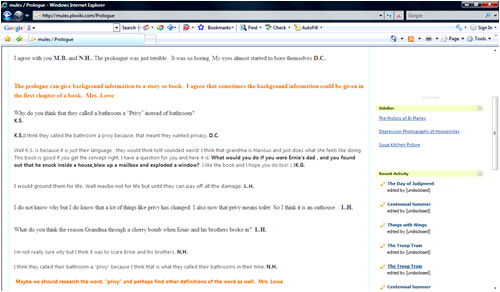
Figure 3. Screen shot of The Mules Reading Group Wiki.
In this example, vocabulary development occurred organically through an authentic discussion among peers. Instead of the teacher providing a definition, the wiki offered students the opportunity to learn from each other and to come to a deeper understanding of the meaning of the word through their dialogue.
Furthermore, in the midst of their literary discussion, students stopped to reflect on their participation in the wiki environment. K. G. commented, “I don’t know about you but I love the talking back and forth.” N. H. agreed a couple of lines later, saying, “I like the writing back and forth” (see Figure 4).
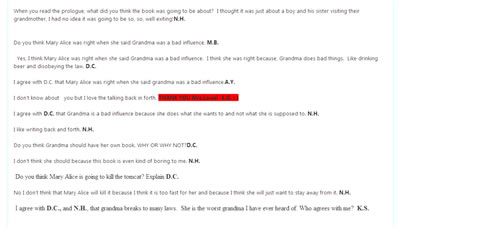
Figure 4. Screen shot of The Mules Reading Group Wiki.
Students clearly recognized the value of peer interactions in this effort; the wiki provided an environment in which collaboration was identified as the key to greater literacy understanding.
3. In what ways can teachers’ use of wikis promote critical literacy opportunities, such as evaluating content and considering different points of view? The options available to digitally create, access, and share information across time and space with peers provide opportunities for exposure to a wide range of texts that may or may not be meaningful or worthwhile. Students are sometimes willing to accept blindly any information found online, forgetting the collective accumulation of knowledge on which it was built. The need to acquire critical analysis skills can be met when students are prompted to become participants in the social experiment of community knowledge accumulation that is afforded on a wiki site (Siegle, 2008). If, for example, teachers supplied all of the sources of information on the wiki, students would not be presented the opportunity to learn how to read, analyze, and evaluate various texts. Providing a variety of sources as well as letting students offer their own, followed by explicit instruction on how to evaluate information and sources, as well as how to analyze who is given voice and who is silenced, can help to develop students’ critical literacy skills.
In electronic modes of literacy, just as in traditional text formats, students must be challenged to view with a critical eye the wide range of information at their disposal. On RMS102, a wiki created for use in a middle school technology literacy class, the teacher provided explicit instruction to accompany students’ online ventures. Figure 5 shows a page titled Searching Online, on which the teacher supplied links such as Searching for a Search Engine, Can I Trust This Website, and Five Critical Areas to Think About When Evaluating a Website.
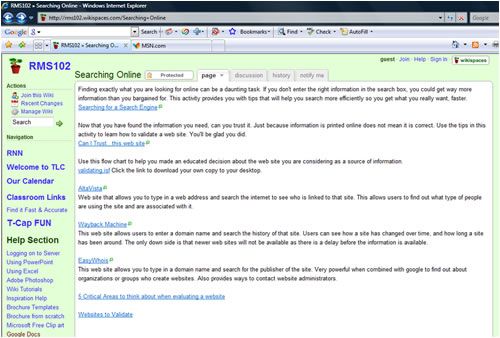
Figure 5. Screen shot of RMS102 wiki.
The students were being provided tools to learn how to evaluate communication effectively, both their own and that of others, in electronic formats. Such guidance encourages students to view with a discerning eye the wealth of information available to them, furthering their critical participation in online environments.
4. In what ways can teachers’ use of wikis allow for the processing, managing, analyzing and synthesizing of multiple streams of information? In this Web 2.0 world, the variety of literacy opportunities in which students can engage on a daily basis is staggering. Without a structure in which to ground this (over)abundance of information, students can become overwhelmed. Although they may already be accessing online and offline resources, they may lack the knowledge required to utilize them effectively (Loertscher, 2007). The creation of learning spaces such as wikis, under the guidance of more experienced interactants, can promote the development of management skills required to deal with the wealth of information available to them in both digital and nondigital formats. Simply opening the doors to a wiki or other online learning community without providing guidance and instruction will not allow students to learn how to sort through the vast amounts of information presented to them.
Students faced with a multitude of communication sources in both traditional and electronic environments can quickly become lost in a literacy jungle if they lack management strategies. On TheWright3 Wiki, elementary educator Nancy Bosch supplies information about managing text creation in an electronic format in conjunction with providing space for students to build text understanding. On the home page of a wiki created to encourage students’ text response, Bosch discussed topics such as plagiarism and citations, and she explained technical skills such as creating links and adding images. For example, worked into directions for responding to the assignment are Bosch’s reminders to guide their use of the technology: “We are going to use this space to tell others about Frank Lloyd Wright and the book, The Wright 3 by Blue Balliett. Use the navigation bar on the left to edit the page you are assigned. Remember to link every word you can to a different section of the wiki” (see Figure 6).
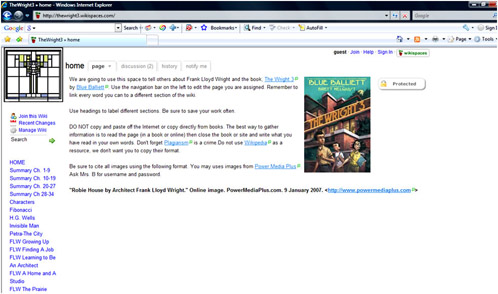
Figure 6. Screen shot of TheWright3 wiki.
Students were able to participate more deeply in the creation of collaborative understandings surrounding the class text because they were not left to flounder in a sea of unfamiliar formats. Their teacher recognized the importance of guided opportunities to experience and synthesize old and new literacies as well as the opportunities such knowledge holds for ongoing literacy development.
5. In what ways can teachers’ use of wikis aid in developing literacy strategies for managing different types of text in a variety of contexts? In addition to the amount of information available to students, the options available in old and new literacies may actually limit students’ learning because of their unfamiliarity and accompanying unease with the variety of layouts. Loertscher (2007) pointed out that digitally connected students might not even be fully aware of the online tools available that can enlarge their literacy productivity. Exposure to the knowledge sharing capabilities of wikis can provide students opportunities to view and create text in an array of configurations.
On the other hand, a wiki that is limited to word processing or one whose information can all be printed out and handed to students on a piece of paper is not fully utilizing all of the learning possibilities that a wiki can provide. Teachers should encourage the use of other means of communication such as hypertext, audio and visual recordings, photographs, and opportunities for remix (Lankshear & Knobel, 2006) as part of their wiki contributions. This exposure, accompanied by thoughtful teacher guidance that makes explicit the ways to deal with various textual formats, can enrich students’ options of literacy consumption and production. The Mules Reading Group Wiki, a site created for fourth graders, is a wonderful example of how students’ knowledge of different types of texts can be enhanced as they work with a wiki. On this site, the progression of posts surrounding the students’ reading of a class text reflected their increasing awareness of technology to get their points across. Posts became more colorful as students commented on various aspects of the books that they were reading; they experimented with different fonts, emoticons, shading, and other electronic features that allowed them to stretch the boundaries of media production. In their response to a discussion about a class novel, L. H. and C. F. used capitalization and text color to add emphasis as they asked fellow contributors, “Would you EVER have the nerve to throw a cherry bomb at another person? WHY? WHY NOT?” (see Figure 7).
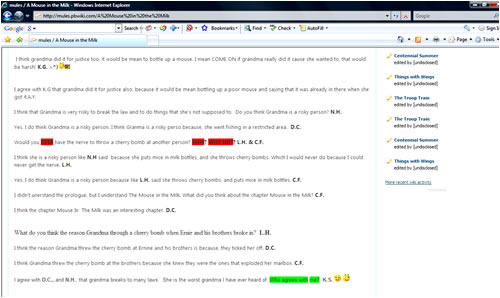
Figure 7. Screen shot of The Mules Reading Group Wiki.
Even at this beginning level, dialogue in the wiki format allows students to become more aware of the potential of text to convey authors’ messages. In using the wiki as a vehicle for experimentation with electronic features, students demonstrated their developing strategies for producing and managing literacy in diverse formats.
6. In what ways can teachers’ use of wikis value and utilize students’ cultures, experiences, and funds of knowledge? Students’ participation in family, community, and institutional bodies outside school settings holds enormous potential to contribute to their academic learning when these experiences are viewed as assets rather than as deficits (Lee, 2007). As students are prompted to add to a growing body of learning on a wiki, these contributions based on their life experiences are valued as information sources. The knowledge that students contribute to wikis puts them in command of their own information spaces and enables them to create and maintain knowledge bases that are relevant to their unique needs, experiences, and interests (Loertscher, 2007). In this way, they are put in the driver’s seat rather than the back seat of their knowledge creation.
Merely providing a classroom wiki does not utilize nor celebrate students’ unique backgrounds and funds of knowledge (Moll et al., 1992), especially if the content is teacher driven. When teachers refuse to relinquish some of the content control of the wiki, it is no longer a manifestation of the students’ growing knowledge but merely a reflection of the teacher. Making the wiki creation a true collaboration among all members of the learning community allows literacy development to be enhanced through the valuing of the knowledge of all rather than just of a privileged few.
Students come into formal education venues already holding a wealth of prior knowledge that can enrich their school experience if it is appropriately valued and utilized. On Good News Lutheran School Wiki, created by Good News Lutheran School in Brisbane, Australia, students contributed to the wiki after researching cultural groups of which they are members or that are prevalent in their geographic area. On one page, shown in Figure 8, sixth-grade students researched aspects of traditional and modern Maori culture, reporting their results regarding food traditions that are still practiced in modern-day New Zealand.
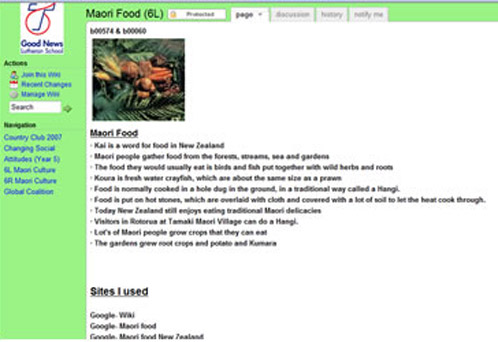
Figure 8. Screen shot of Good News Lutheran School Wiki.
On another page in the wiki, a group of fifth-grade students researched changing social attitudes that were evident between cultural groups in their country. They commented, “The Chinese gradually became a respected race in Australia and there are no fines or laws against the Chinese race now. The Chinese are one of the most common races in Australia” (see Figure 9). Being allowed to research and report on significant issues directly impacting these students’ cultural and national identities evidences a valuing of their out-of-school experiences as worthy of inclusion in the education process.
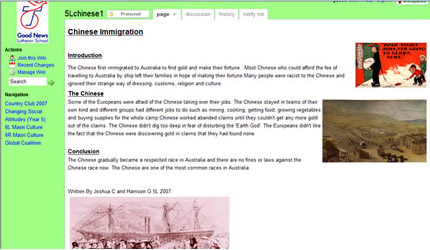
Figure 9. Screen shot of Good News Lutheran School Wiki.
Conclusion
As Luce-Kapler (2007) pointed out, new literacies require broader definitions of effective teaching modalities. In reviewing the six principles of this evaluation framework, it becomes apparent that, as with any pedagogical tool, new technologies such as wikis can be effective in addressing these evolving pedagogical needs only if incorporated in instruction in thoughtful and authentic ways. Looking at the examples of wikis currently being integrated into language arts classrooms across the nation exemplifies the amazing possibilities that exist in integrating technology with literacy learning. When teachers evaluate not only their choice of technology but also their forms of implementation, they are enabled to provide informed instruction that effectively utilizes the potential of technology to address the needs of 21st-century learners.
Viewed through the lens of this evaluative framework, wikis epitomize the potential for new technologies to create an environment in which learning is a collaborative journey. As new forms of literacies grow and change, educators need to be less focused on enlarging content knowledge among their students and more focused on involving students in the process of their own knowledge growth. Though educators are ever cognizant of the fact that technology alone is not the panacea that will solve the literacy struggles of students, a thoughtful integration of literacy instruction with new technologies such as wikis can serve as the vehicle to transport both teachers and their students of this Web 2.0 generation on their learning journeys in ways that are broader and more meaningful than any individual learner could travel alone.
Blue Balliett – http://teacher.scholastic.com/authorsandbooks/events/balliett/index.htm
Good News Lutheran School Wikispace: http://goodnewslutheran.wikispaces.com/
Mules Reading Group wiki: http://mules.pbwiki.com/
PBWorks: http://pbworks.com/academic.wiki
RMS102 wiki: http://rms102.wikispaces.com/
SHS AP Literature & Composition Wiki: http://shsaplit.wikispaces.com/
TeachersFirst: http://www.teachersfirst.com/content/wiki/
Wiki Spaces: http://www.wikispaces.com/site/for/teachers
Wikia: http://www.wikia.com/wiki/Wikia
WikiWorks: http://wikiworks.com/
The Wright 3 – http://scholastic.com/titles/chasingvermeer/index.htm
TheWright3 Wiki: http://thewright3.wikispaces.com/
References
Cummins, J., Brown, K., & Sayers, D. (2007). Literacy, technology, and diversity: Teaching for success in changing times. Boston, MA: Pearson.
Engstrom, M. E., & Jewett, D. (2005). Collaborative learning the wiki way. TechTrends, 49(6), 12-15.
Godwin-Jones, R. (2003). Blogs and wikis: Environments for on-line collaboration. Language Learning and Technology, 7(2), 12-16.
Lankshear, C. K., & Knobel, M. (2006). New literacies: Everyday practices and classroom learning. New York, NY: Open University Press.
Lee, C. D. (2007). Cultural, literacy, and learning: Taking bloom in the midst of the whirlwind. New York, NY: Teachers College Press.
Loertscher, D. (2007). Children, teens, and the construction of information spaces. Teacher Librarian, 35(2), 14-17.
Luce-Kapler, R. (2007). Radical change and wikis: Teaching new literacies. Journal of Adolescent and Adult Literacy, 51(3), 214-223.
Mindel, J. L., & Verma, S. (2006). Wikis for teaching and learning. Communications of the Association for Information Systems, 18, 1-23.
Moll, L. C., Amanti, C., Neff, D., & Gonzalez, N. (1992). Funds of knowledge for teaching: Using a qualitative approach to connect homes and classrooms. Theory into Practice, 31, 132-41.
National Council of Teachers of English. (2008, February). NCTE position statement: The NCTE definition of 21st century literacies. Retrieved from http://www.ncte.org/positions/statements/21stcentdefinition?source=gs
Prensky, M. (2001). Digital natives, digital immigrants. On the Horizon, 9(5), 1-6.
Raman, M., Ryan, T., & Olfman, L. (2005). Designing knowledge management systems for teaching and learning with wiki technology. Journal of Information Systems Education, 16(3), 311-320.
Siegle, D. (2008). Working with wikis. Gifted Child Today, 31(1), 14-17.
Author Note
Sherry Sanden
Washington State University
email: :[email protected]
Janine Darragh
Whitworth University
email: [email protected]
![]()